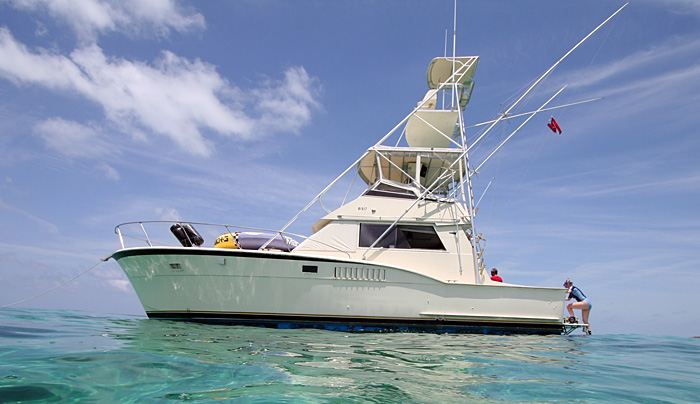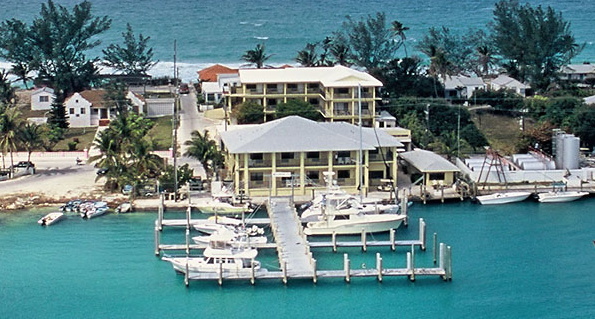Regrettably, DCP has suspended our Bimini, The Bahamas, college courses until further notice. Our university partners, Sacred Heart University and Eastern Kentucky University, will continue their courses with Sea Crest Hotel & Marina. DCP hopes to resume facilitating these programs in the future!
Upcoming Course Options: These are courtesy postings only. These courses are not run in collaboration with DCP at this time.
University of New Brunswick: Stay Tuned!
Eastern Kentucky University: Dr. Radhika Makecha’s 2023 return to Bimini is in the works for 16 – 28 July 2023. If you are an EKU student, or at another nearby university, let her know you are interested! Contact Dr. M today!
Sacred Heart University: Dr. Deirdre Yeater’s Bimini course is planned for 12-19 May 2023 with additional online requirements. All participants must take the course for SHU credit, but with online and field components, non-SHU students are welcome & encouraged to apply. Contact SHU today to register!
While DCP’s participation in these field courses is on hold, below you’ll find information on our past courses:
The Dolphin Communication Project offers a custom field course in cetacean ecology in conjunction with a number of different universities throughout the world. If you are a university professor or field-course organizer looking to bring your students to Bimini to learn more about dolphin and marine science, please check out the contact page to query DCP for more information. If you are a student, please watch the DCP website for upcoming course offerings, or contact your professors to ask if they might be interested in setting up a field course with DCP. A general overview if the Bimini field site and potential course subject material is included below.
Field Course in Cetacean Ecology – Bimini, The Bahamas
{vimeo}126303523{/vimeo}
The Island
The island, or more accurately islands, of Bimini lie less than 50 miles off the east coast of Florida. In fact, if you look to the west after sunset, you can see the lights of Miami. Bimini may be just a 20 minute plane ride from the U.S., but this most westerly inhabited island of The Bahamas feels a world away. Only a few hundred yards wide in some areas, Bimini is known for fishing, SCUBA diving and, of course, dolphins.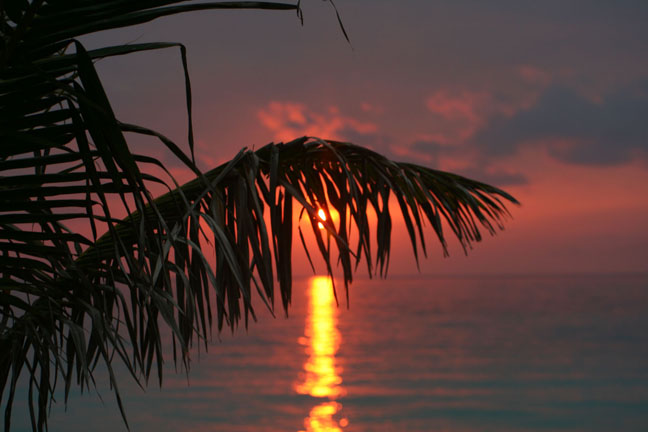
The Water
Bimini lies at the northwestern edge of the Great Bahama Bank, a vast area of warm, shallow water over a sandy seafloor. Portions of the island are made up of intricate mangrove systems, which in addition to great kayaking, are home to dozens of juvenile fish species. This important nursery ground is thought to be the source for many of the fish that grow up to populate other areas of The Bahamas. Immediately to the west of Bimini, and in stark contrast to the Great Bahama Bank, is the Gulf Stream (aka Florida Straights). The waters swiftly flowing north through this deep ocean trench provide a constant supply of “fresh” water and nutrients to the area, including fish such as mackerel and mahi mahi. It is thought that the dolphins around Bimini spend the majority of their time in the relative safety of the bank, while cruising out to deep water to feed.
The Dolphins
The group of Atlantic spotted dolphins (Stenella frontalis) studied by DCP off the coast of Bimini are thought to be resident animals – meaning that each individual is born and raised, has its own calves and lives out the entirety of its life in the waters immediately surrounding Bimini. Although spotted dolphins are born without spots, they can be recognized by their individual spot pattern, which begins to develop around the age of 3 or 4 years. By documenting individuals through photographs and video, we can track the population over time and confirm that we do see the same individuals year after year. Since the animals develop new spots throughout their entire lives, it is important that DCP researchers are able to document as many individuals as possible each year.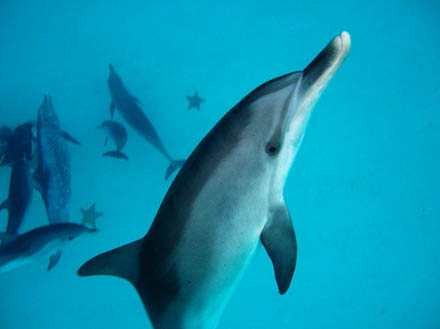
There are also common bottlenose dolphins (Tursiops truncatus) found off the coast of Bimini. At the moment, we know significantly less about these individuals, however, that is slowly changing. Members of this species are recognized by nicks in their dorsal fins, which are photographed as the animal breaks the surface to breathe. These photographs are supplemented with full body images from underwater video when possible. There does appear to be some residency pattern among what may be “coastal” bottlenose dolphins. It is also likely that there is an “offshore” bottlenose group, however their exact composition and interaction with the coastal dolphins is not known at this time.
Dolphin Communication Project
The Dolphin Communication Project (DCP) is focused on the dual goals of scientific research and education: we take results from research projects and disseminate them into educational programs for students of all ages. DCP has a team of researchers (graduated professionals, graduate students, undergraduate interns and volunteers) who work 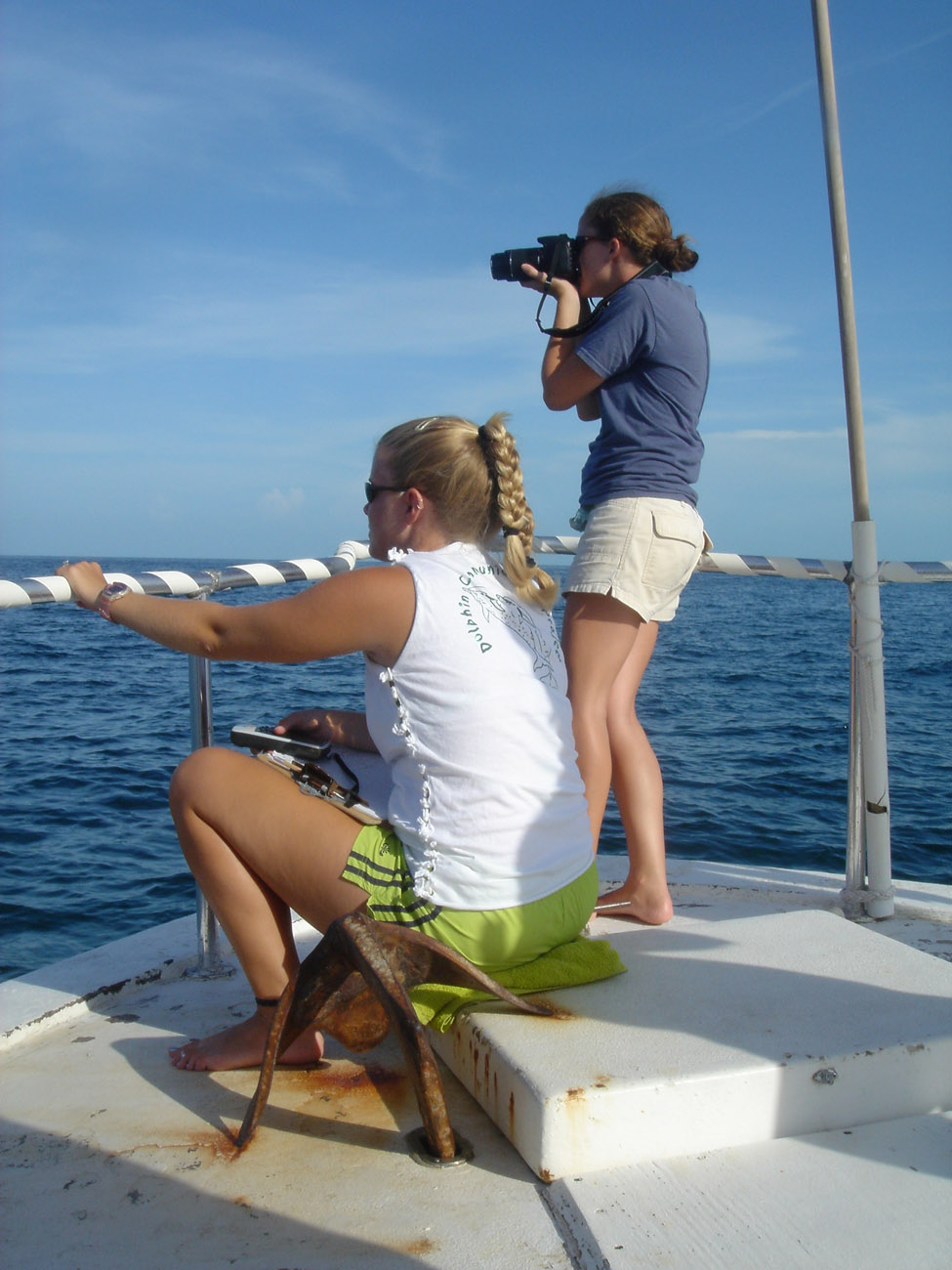 together to promote the scientific study of dolphins and inspire their conservation. We have 4 field sites that include wild and captive dolphins of 3 species. North Bimini Island in The Bahamas is one of these sites. Since 2001, we have been actively working with locally owned and operated eco-tour companies as part of a longitudinal study on the wild populations of Atlantic spotted (Stenella frontalis) and bottlenose dolphin s (Tursiops truncatus) in this area. As part of such studies, we invite you and your students to complete a field course at our Bimini field site. This packet is the first step in developing such a course and provides details on the options available to you. Each course is designed to be tailored to the specific needs of your university, program and students. Please contact us (see below) for information.
together to promote the scientific study of dolphins and inspire their conservation. We have 4 field sites that include wild and captive dolphins of 3 species. North Bimini Island in The Bahamas is one of these sites. Since 2001, we have been actively working with locally owned and operated eco-tour companies as part of a longitudinal study on the wild populations of Atlantic spotted (Stenella frontalis) and bottlenose dolphin s (Tursiops truncatus) in this area. As part of such studies, we invite you and your students to complete a field course at our Bimini field site. This packet is the first step in developing such a course and provides details on the options available to you. Each course is designed to be tailored to the specific needs of your university, program and students. Please contact us (see below) for information.
Course Structure
Some programs will be fulfilled in their entirety on Bimini, while others will have a classroom component to be completed at the home institution before and/or after the field portion. In both scenarios, pre-travel coordination is recommended with DCP Bimini Research Manager, Kel Melillo Sweeting, who is available via phone or Skype conference, if needed. Below is a list of topics suggested as part of a Bimini field course syllabus. If snorkel safety is not completed prior to arrival in Bimini, time must be allotted for this task upon arrival. Instructors are responsible for meeting the risk management requirements of their university. The Bimini component of each course can range from 6 – 15 days.
Sample Topics
- Introduction to delphinid species of Bimini
- Introduction to cetacean biology
- Introduction to the coastal ecology of Bimini, The Bahamas
- Scientific method and observational research: techniques & applications
- Boat based surveys & DCP’s mobile video acoustic array (Dudzinski et al. 1995)
- Photo-identification of cetaceans & video analysis (lecture & practical)
- Behavioral ethograms: application to Bimini’s dolphins
- Eco-tourism: finding the balance
Daily Activities
Field work on Bimini generally consists of 4-5 hour boat trips in a pre-designated survey area. Lecture topics (listed above) can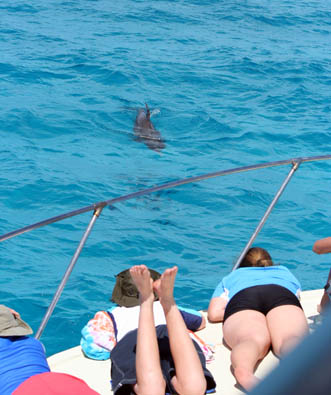 be covered in the morning hours, with boat surveys completed in the afternoon. This schedule can be altered according to the needs of your specific course. Kelly Melillo Sweeting is available to cover certain topics and/or provide support for lectures given by the home instructor. A list of suggested primary literature can be provided as reading material for each topic chosen.
be covered in the morning hours, with boat surveys completed in the afternoon. This schedule can be altered according to the needs of your specific course. Kelly Melillo Sweeting is available to cover certain topics and/or provide support for lectures given by the home instructor. A list of suggested primary literature can be provided as reading material for each topic chosen.
While on-board the survey vessel, students will be responsible for posted watches, data sheets, GPS operation, etc. Once dolphins are in view, students will need to note depth, species, group size and composition, behaviors and known individuals. If the group is able to make underwater observations, students will be in pairs (for safety and cooperative learning) and will rotate the use of underwater slates, video camera and digital still cameras. Two students will be required to stay onboard the vessel in order to note surface observations. Students may be asked to assist with daily cleaning of the vessel at the end of each day. Students will then be assigned the task of identifying the dolphins in their still photographs or slate sketches, either in pairs or as an entire class. These photographs will contribute to DCP’s photo-ID catalog. The DCP research leader will be participating in underwater observations and recording video and acoustic data with the MVA system. These video data can also be used during non-boat class time to showcase logging videos for individual dolphins and behaviors.
Additional Topics
If you are looking to go beyond cetaceans in your course, Bimini offers the perfect field setting for topics in shark and ray biology, reef fish identification and mangrove systems. Boat time can be shifted from dolphin surveys to any of these topics, or additional boat time may be added. Examples of field options for additional topics are listed below. It is also possible for certified students to add SCUBA to their trip, however this must be done outside of allotted course time and fees.
Reef Fish Identification: Boat captain provides the option to begin a boat trip with a brief snorkel stop. These sites are on the way to the “dolphin grounds” and provide a good example of reef fishes in this area. Roughly 2 snorkel stops per 5 dolphin trips is included in the course fee. Additional snorkeling can be added.
Sharks: It is possible to “trade” a dolphin boat trip or add an additional boat trip to see Caribbean reef sharks (most common species, regularly “chummed”). A visit to the South Bimini Biological Research Station on South Bimini for a tour can be arranged. If the team there has free time, tours and short explanations are free, however the possibility of more formal lectures require a fee. Short ferry and taxi rides to South Bimini required.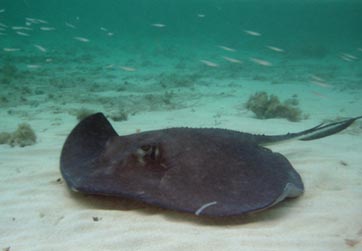
Sting rays: It is possible to “trade” a dolphin boat trip or add an additional boat trip to see southern sting rays (human fed during encounters). Sting rays can be done in conjunction with sharks (see above).
Mangroves: Possibility to add a tour of the mangroves for an additional fee. Knowledgeable local guides are available. Prices are available on request.
Logistics
The Boat
A 42’ Hatteras (12-18 passengers, including instructor and DCP researcher). This boat is locally owned and operated. Our captain has over 20 years experience on the waters of Bimini.A smaller, but comfortable boat is used for smaller groups.
Lodging
SeaCrest Hotel and Marina. The locally owned and operated hotel has several options. The “suite” with multiple bedrooms as well as cooking and living space suitable for meals and teaching is recommended. Additional hotel rooms will be added to supplement sleeping space. Standard hotel rooms have two double beds, ensuite bathroom, A/C , TV. Rooms are most commonly double occupancy.
Travel
Flights to South Bimini (BIM) originate in Ft. Lauderdale/Hollywood International (FLL) or Nassau, The Bahamas (NAS). There is now a ferry option, but specifics vary by year. Travel through FLL is recommended, particularly if scheduling requires a night’s layover (typically only 1 flight to/from Bimini per day in the off season). Contact DCP for a list of current airlines providing service to Bimini. US Citizens are required to travel with a valid passport. Birth certificates are no longer adequate for entry into The Bahamas. People with other citizenship should check with their native country. North Bimini is a short taxi (land and water) ride from the South Bimini airport. These services run regularly and are included in the course fee.
Food
Fully catered options (family-style meals) are available and are recommended. Details are available upon request. Self-catering is also possible, however, groceries are limited and more expensive than in the states. Groceries may be brought onto Bimini from the U.S.; each individual is allowed $100 of food duty free, however it is important to consider baggage allowances/excess baggage fees.
Weather Conditions
Weather patterns in Bimini can be unpredictable. During the winter, there is virtually no risk of major storms; however cold fronts can cause rough sea conditions that prohibit boat trips. During the summer, sea conditions tend to be consistently more favorable, but the risk of major storms increases. There are no refunds for boat trips cancelled due to weather, however every effort will be made to offer alternative, active learning experiences (such as mangrove tours).
Dolphin Sightings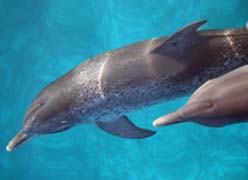
The Atlantic spotted and bottlenose dolphins off Bimini, The Bahamas are wild. Therefore, there is no guarantee that we will see dolphins, however the sighting success rate has been between 80-90% since 2003. Students will be exposed to the challenges of weather and subject dependent field work.
Money
In Bimini, the national currency is the Bahamian Dollar; however, U.S. dollars are accepted at a 1:1 ratio. The local bank can cash traveler’s checks for a small fee or provide cash advances on credit cards. There is also an operating ATM.
Fees
Fees vary based on the specifics of your individualized course. Here is an example course structure:
- 6 nights’ accommodation (double occupancy)
- 5, 4-5 hour boat trips of your choosing
- 3 meals/day for 5 days
- Meeting space
- Gratuity (hotel, cook, boat crew)
- Bimini-only airport/hotel transfers
- DCP facilitator fee
- VAT (tax in The Bahamas)
*Travel to/from Bimini is NOT included
Minimum enrollment is generally 10 paying students and includes 1 “free” slot for you, the home institution instructor.
DEPOSITS/PAYMENTS/REFUNDS
If booking during November, December, January or February, excluding holidays, deposit amounts and due dates are flexible. Details are available upon request. Payment options include bank wire, PayPal or U.S. check. A deposit of 20% is required at the time of booking. Full payment is required within 90 days. Refund policy will be provided when all details are discussed.
Contact DCP at info {at} dcpmail {dot} org or via snail mail for more info:
Dolphin Communication Project
P.O. Box 7485
Port Saint Lucie, FL 34985

